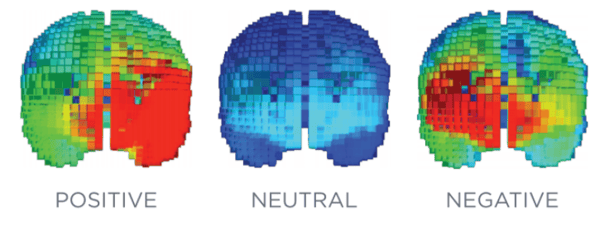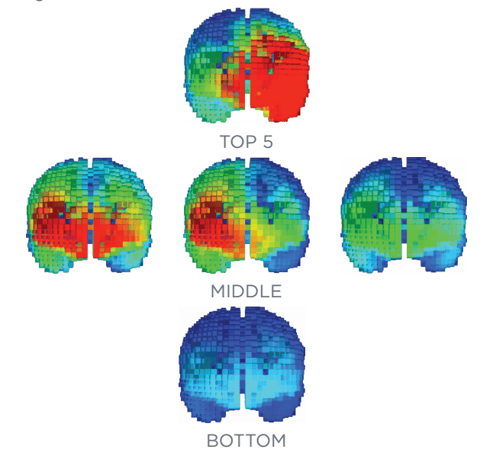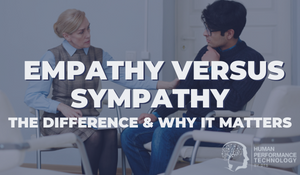Brain Imaging and the Future of Psychometric Testing
In 2011, our research partner and psychometric assessment provider, TTI Success Insights, began conducting brain research using electroencephalographic (EEG) electromagnetic tomographic analysis (ETA) imaging techniques.
This provides TTI Success Insights and their distributors, like our team at Human Performance Technology by DTS, with a unique mechanism for exploring decision making. With these new insights, individuals can better understand the emotional triggers that affect one’s daily decisions.
Understanding Brain Imaging through a Case Study
A female athlete, who was well known in the sporting world, participated in one of the EEG research projects with TTI Success Insights. She had 16 electrodes connected to her scalp to collect data from her subconscious in a fraction of a second. In this situation, there’s no time for the conscious mind to deliberate about the meaning and feelings behind each word. The EEG measures gut reactions - how you really feel deep down inside, even if you are trying to hide something.
Here is a video with Dr. Ron Bonstetter, VP of Research at TTI Success Insights, talking about this case study:
The accomplished athlete showed negative reactions to words connected to food and body weight. When the researchers began probing about this negative response, the woman revealed she had suffered from anorexia earlier in her life. While she had overcome this physical and mental health condition, she didn’t realise how much of her daily decisions were still afflicted by subconscious negative sentiments.
Figure 1 below shows an emotional response to three different stimuli. (The brain image is facing you, so the left hemisphere image is on your right.)
A relative balance in gamma waves creating symmetry in the activity in the frontal lobes is associated with normal mood and emotional state (the middle image). Increased activity within the left prefrontal cortex can indicate an elevation in mood and positive feelings (the far left image below). De-activation in the left prefrontal cortex alone, or in combination with an increase in activity within the right prefrontal cortex, can suggest the opposite, which is associated with a depressive mood, negative thoughts or an aversion to the concept (the far right image).
Thus, we can group our brain images into one of three stimuli responses: acceptance or a positive response, a neutral or mixed response, or an aversion or negative reaction.

Figure 1: Emotional response to three different stimuli.
Of course, it's not unusual for people to be opposed to certain ideas or concepts, but to actually see the intensity of the reaction in the brain (as per the case study video) is something altogether different and potentially very useful in supporting this athlete’s physical and mental health.
This type of brain research is currently being used to refine and improve the TTI Success Insights suite of psychometric assessments. The EEG technology helps to evaluate people’s responses to different words in the assessments and improve the validity of the assessments to the highest levels ever recorded.
Current Research and Findings
New research affirms skills are experience-based and tied directly to emotional reactions. These emotional attachments can be affirmations or aversions. That means you can have positive acceptance to a soft skill, or you can have a very negative subconscious reaction.
If you have had little or no exposure to a skill, you simply may not have any emotional or memory connection to that skill. In that case, there is little to no brain reaction (i.e. no meaningful neurological response).
Applying the Findings
Three outcomes emerge from our skill level research. See Figure 2 below.
First, when you respond to an assessment about your skills, your brain images are in agreement regarding the top five skills, almost 100% of the time.
Second and just as significant, is the reaction to those skills with some mastery that fall in the middle range of a list of skills. The brain imaging shows mixed reactions with some being more positive, some more negative and some with a mixed response.
The third grouping involves those skills a person has rated in the assessment that they do not possess. And guess what? The brain imaging suggests they have had very little or no experience with the concept, and thus, no emotional connection. The brain reacts with minimal activity.

Figure 2: Sample images from the TriMetrix DNA soft skill assessment.
Note how the sample from the top five soft skills shows a strong left prefrontal cortex gamma response, demonstrating concept agreement or acceptance. The middle three images depict three different reactions associated with those skills with some mastery. From left to right, you see an image with a great deal of red on both sides, showing recognition, but a mixed reaction. The middle image actually shows a negative response, and the right image shows again recognition but a mixed reaction. Then, we see a sample from the lower ranking skills. Here we find reduced brain activity. This can only occur when the brain is unable to connect with any emotional recall and thus we see little reaction.
Again, the EEG technology helps to evaluate people’s responses to different words in the current assessments (in this case, the TriMetrix DNA) and improve the validity of the psychometric assessments to the highest levels ever recorded.
Reference
The content from this article was shared with permission from TTI Success Insights.
Bonnstetter, R., Bonnstetter, B. J., Hebets, D. (2015). Uncovering Training Challenges with Brain Imaging. Unpublished paper, Target Training International, Ltd., Scottsdale, AZ.
Note: This article was originally shared on 4 October 2013, and it was refreshed and republished in February 2021 with up to date information and context.

Theo Winter
Client Services Manager, Writer & Researcher. Theo is one of the youngest professionals in the world to earn an accreditation in TTI Success Insight's suite of psychometric assessments. For more than a decade, he worked with hundreds of HR, L&D and OD professionals and consultants to improve engagement, performance and emotional intelligence of leaders and their teams. He authored the book "40 Must-Know Business Models for People Leaders."



We Would Like to Hear From You (0 Comments)